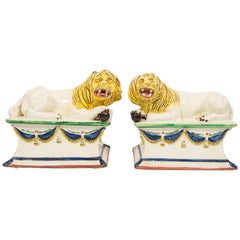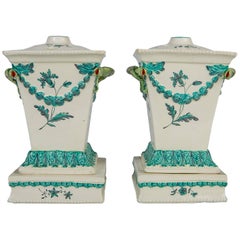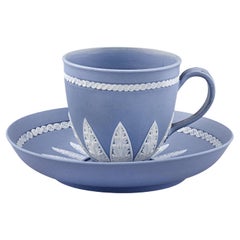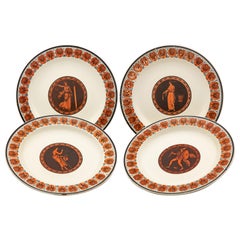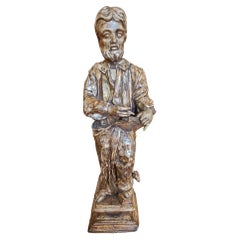18th Century and Earlier Ceramics
25
to
2
7
6
25
25
25
158
32
29
25
3
2
2
1
1
1
25
32
29
2
9
9
2
1
1
2
25
12
9
4
4
25
17
16
5
2
11
2
1
1
Style: Neoclassical
Period: 18th Century and Earlier
Italian Maiolica Pharmacy Flasks Felice Clerici, Milan Circa 1770-1780
Located in Milano, IT
Two maiolica pharmacy flasks
Milan, Felice Clerici Manufacture, 1770-1780
They each measure 9.44 in (24 cm) in height x 6.10 in (15.5 cm) in diameter
lb 4 (kg 1.8)
State of conserva...
Category
Italian Neoclassical Antique 18th Century and Earlier Ceramics
Materials
Maiolica
Antique French Creamware Lions 18th Century
Located in Katonah, NY
We are thrilled to offer this exceptional pair of creamware lions, each elegantly resting on a tall base adorned with sumptuous swags of dark blue "curtains" with gleaming yellow tassels and trim.
Crafted in France, these figures are unparalleled and truly a masterpiece of 18th-century creamware.
They date back to the late 18th century, circa 1790. Each lion's head and mane is exquisitely painted with vibrant yellow and lined in striking midnight brown. Their mouths are painted in delicate pink, adding an extra touch of charm.
Not only are these lions a sight to behold, but they will also bring a touch of humor to your home. Their jovial expressions make it impossible not to laugh along with them.
Leisurely resting on cushions draped with rich fabric and tassels, these friendly lions exude a very French attitude, seamlessly blending formality and friendliness.
Placed on a mantel, they would undoubtedly be the focal point of any room, commanding attention, and admiration from all who see them. These lions are genuinely a one-of-a-kind treasure that is not to be missed.
Dimensions: 6.5 inches tall x 6.75 inches long x 4.5 inches wide
Condition: Excellent
Price: $3200
Background of creamware
Creamware is the name given to a type of earthenware pottery initially made from white clays from Dorset and Devonshire combined with an amount of calcined flint.
Creamware was first produced in England sometime before 1740. Foremost of the pioneers of creamware in the Staffordshire Potteries was Thomas Whieldon. The young Josiah Wedgwood partnered with Thomas Whieldon from 1754-1759. When Wedgwood left to set up his own business, he immediately directed his efforts to developing creamware.
Around the same time, in the mid-18th century, French potters developed their creamware known in France as "Faience Fine...
Category
French Neoclassical Antique 18th Century and Earlier Ceramics
Materials
Creamware
Creamware Pair of English Flower Holders, 18th Century circa 1780
By Neale & Co.
Located in Katonah, NY
WHY WE LOVE IT: One of our absolute favorites!
A pair of 18th-century creamware flower holders complete with stands and covers made in England by Neale & Co. was one of the finest 18...
Category
English Neoclassical Antique 18th Century and Earlier Ceramics
Materials
Creamware
Ancient Pair Coffee Pots, Pasquale Rubati Manufacture Milan, 1770 circa
Located in Milano, IT
Pair of small coffee pots.
Manufacture of Pasquale Rubati
Milan, 1770 Circa
Maiolica polychrome decorated “a piccolo fuoco” (third fire).
a) height 7.87 x 5.51 x 3.93 in (20 x 14 x ...
Category
Italian Neoclassical Antique 18th Century and Earlier Ceramics
Materials
Maiolica
Wedgwood Pale Blue Jasperware Coffee Cup and Saucer
By Wedgwood
Located in New Orleans, LA
Crafted by Wedgwood, this exquisite and rare assembled coffee cup and saucer set are comprised of the firm’s famous pale “Wedgwood blue” jasperware so prized by collectors and connoi...
Category
English Neoclassical Antique 18th Century and Earlier Ceramics
Materials
Ceramic
Early Wedgwood Neoclassical Creamware Dessert Dishes Made circa 1780
By Wedgwood
Located in Fort Lauderdale, FL
A set of four early Wedgwood creamware Neoclassical dessert dishes made circa 1780.
Sir William Hamilton’s Collection of Etruscan, Greek and Roman an...
Category
English Neoclassical Antique 18th Century and Earlier Ceramics
Materials
Creamware
Encaustic Painted Cup and Saucer in Black Basalt, Wedgwood C1790
By Wedgwood
Located in Melbourne, Victoria
Black basalt, with rope handle and encaustic decoration of lines & anthemion, in imitation of early Greek pottery. Early encaustic examples are rar...
Category
English Neoclassical Antique 18th Century and Earlier Ceramics
Materials
Stoneware
Faience Blue and White Water Cistern, Rouen or Lille, French Work, 18th Century
Located in Marcq-en-Barœul, Hauts-de-France
Water cistern, table fountain on earthenware pedestal decorated with lambrequins and lions in blue camaieu. Lateral grip in the shape of a lion's head. Earthenware from Rouen or Lill...
Category
French Neoclassical Antique 18th Century and Earlier Ceramics
Materials
Earthenware
Pair of Triton Candlesticks. Palmer C1780.
By Palmer
Located in Melbourne, Victoria
An exceptionally rare pair of Triton candlesticks, in black basalt with gold lustre. The design is copied from Wedgwood, who took it from Sir Willi...
Category
English Neoclassical Antique 18th Century and Earlier Ceramics
Materials
Stoneware
Encaustic Painted Teapot in Black Basalt, Wedgwood C1780
By Wedgwood
Located in Melbourne, Victoria
A rare and stunning example of neo-classical decoration on an ordinary househuld object: a teapot. The decoration is restrained yet lively, and makes excellent use of classical figur...
Category
English Neoclassical Antique 18th Century and Earlier Ceramics
Materials
Stoneware
Wedgwood Pale Blue Jasperware Coffee Cup and Saucer Set
By Wedgwood
Located in New Orleans, LA
Crafted by Wedgwood, this exquisite and rare assembled coffee cup and saucer set are comprised of the firm’s famous pale “Wedgwood blue” jasperwar...
Category
English Neoclassical Antique 18th Century and Earlier Ceramics
Materials
Ceramic
Black Basalt Cream Pail with Ladle, Turner, C1800
By John Turner
Located in Melbourne, Victoria
A delightful cream pail in black basalt, decorated with Poor Maria and Charlotte at the Tomb of Werther. The associated makes it very special indeed.
Category
English Neoclassical Antique 18th Century and Earlier Ceramics
Materials
Stoneware
Basket-Weave Teapot in Black Basalt, Wedgwood C1790
By Wedgwood
Located in Melbourne, Victoria
A most attractive and unusual teapot in black basalt, moulded with basket-weave decoration and interlocking arches.
Exhibited: Wedgwood, Master Potter to the Universe, Roche Foundat...
Category
English Neoclassical Antique 18th Century and Earlier Ceramics
Materials
Stoneware
Rosso Antico Vase with Black Decoration, Wedgwood, C1790
By Wedgwood
Located in Melbourne, Victoria
A most attractive vase in Rosso Antico, decorated in black basalt with Arabesque on a dimpled ground. The colour of early Rosso is quite different to the 19th century orange body.
Category
English Neoclassical Antique 18th Century and Earlier Ceramics
Materials
Stoneware
Two Pairs of Italian Maiolica Baskets, circa 1780
Located in Milano, IT
Two pairs of maiolica baskets
Antonio Ferretti Manufacture
Lodi, circa 1770-1790
Maiolica polychrome decorated “a piccolo fuoco” (third fire).
Measures: A) Height 3.54 x 6.69 x 9.84 in (9 x 17 x 25 cm);
B) Height 3.93 x 7.48 x 11.02 in (10 x 19 x 28 cm).
Total weight 4.85 lb (2.200 kg)
State of conservation:
A) One of the smaller baskets has some areas of restoration, the other slight chipping from use;
B) One of the larger baskets is intact and the other shows a clearly glued break.
The mold with which the baskets were forged simulates a wicker weave.
The two larger works have high, vertical walls, with branch-shaped handles penetrating the weave. The painted decorations, small polychrome flowers applied only externally, highlight the points where the weaves intersect.
The decision to leave the center of the basket devoid of decoration is highly unusual, but given the size and complexity of the shape, as well as the quality of the enamel, it is possible to hypothesize that it represents a precise choice in manufacturing or for a particular client.
The two smaller baskets have small, twisted handles and, on the outside, reproduce more decisively the characteristic wicker weave, obtained through thin molded lines. The interior exhibits a rich, typical decoration of naturalistic flowers: a bunch centered around a main flower and secondary stems accompanied by small “semis”. The exterior of these works is also adorned with small little flowers where the weaves intersect.
The size and morphological characteristics of the baskets confirm their attribution to the Lodi factory of Antonio Ferretti between 1770 and 1790, during its most successful period; by this point his original reworking of the "Strasbourg" decoration, known as "old Lodi", had achieved great fame even outside Italy.
This decorative choice represented a strong point of the Lodi factory, which established itself thanks to the vivid nature of the colors made possible by the introduction of a new technique perfected by Paul Hannong in Strasbourg and which Antonio Ferretti introduced in Italy. This production process, called “piccolo fuoco” (third fire), allowed the use of a greater number of colors than in the past; in particular, the purple of Cassius, a red made from gold chloride, was introduced. Its use allowed for many more tones and shades, from pink to purple.
The Ferretti family had started their maiolica manufacturing business in Lodi in 1725.
The forefather Simpliciano had started the business by purchasing an ancient furnace in 1725 and, indeed, we have evidence of the full activity of the furnaces from April of the same year (Novasconi-Ferrari-Corvi, 1964, p. 26 n. 4). Simpliciano had started a production of excellence also thanks to the ownership of clay quarries in Stradella, not far from Pavia. The production was so successful that in 1726 a decree of the Turin Chamber came to prohibit the importation of foreign ceramics, especially from Lodi, to protect internal production (G. Lise, La ceramica a Lodi, Lodi 1981, p. 59).
In its initial stages, the manufacture produced maolicas painted with the “a gran fuoco” (double fire) technique, often in turquoise monochrome, with ornamentation derived from compositional modules in vogue in Rouen in France. This was also thanks to the collaboration of painters like Giorgio Giacinto Rossetti, who placed his name on the best specimens next to the initials of the factory.
In 1748 Simpliciano made his will (Gelmini, 1995, p. 30) appointing his son Giuseppe Antonio (known as Antonio) as universal heir. After 1750, when Simpliciano passed away, Antonio was directly involved in the maiolica factory, increasing its fortunes and achieving a reputation on a European level. Particularly important was the aforementioned introduction in 1760 of the innovative “a piccolo fuoco” (third fire) processing, which, expanding the ornamental repertoire with Saxon-inspired floral themes, could commercially compete with the German porcelains that had one of its most renowned offerings in the naturalistic Deutsche Blumen. Antonio Ferretti understood and promoted this technique and this decoration, proposing it in a fresher and more corrective version, less linked to botanical tables...
Category
Italian Neoclassical Antique 18th Century and Earlier Ceramics
Materials
Maiolica
Black Basalt Teapot with Enamel Decoration, Probably Spode C1800
By Josiah Spode
Located in Melbourne, Victoria
Globular teapot in black basalt, painted with matt white, red and ice blue. Judging by the shape and general appearance, probably by Spode, in imitation of Wedgwood designs of the pe...
Category
English Neoclassical Antique 18th Century and Earlier Ceramics
Materials
Stoneware
Black Basalt Hot Milk Jug with Engine-Turned Decoration, Mayer, C1790
By Elijah Mayer Pottery
Located in Melbourne, Victoria
Baluster-shaped jug, with sparrow-beak spout and cover, for hot milk or hot water. The engine-turned decoration is particularly fine.
Marked.
Category
English Neoclassical Antique 18th Century and Earlier Ceramics
Materials
Stoneware
Ecuelle, or Soup Bowl, Wedgwood, C1790
By Wedgwood
Located in Melbourne, Victoria
Covered bowl, perhaps for soup, in black basalt with ‘Etruscan’ encaustic painting.
Category
English Neoclassical Antique 18th Century and Earlier Ceramics
Materials
Stoneware
Black Basalt Tea Canister with Applied Decoration, Mayer, C1790
By Elijah Mayer Pottery
Located in Melbourne, Victoria
Cyclicrical tea canister in engine-turned black basalt, with raised decoration. Unmarked, but the quality and finial clinch the attribution.
Category
English Neoclassical Antique 18th Century and Earlier Ceramics
Materials
Stoneware
Navette, with Ladle, Wedgwood, C1790
By Wedgwood
Located in Melbourne, Victoria
An extraordinary navette, or cream boat, in black basalt with encaustic decoration. Complete with matching ladle: a rare find indeed.
Category
English Neoclassical Antique 18th Century and Earlier Ceramics
Materials
Stoneware
Ceramic Drug Jar or Syrup Jar, Possibly Italy, 18th Century
Located in Madrid, ES
The decoration of ceramics in blue tones on a white background was common in Europe as far back as the 17th century (Dutch and English pieces, works in Talavera de la Reina in Spain,...
Category
Italian Neoclassical Antique 18th Century and Earlier Ceramics
Materials
Ceramic
Four Italian Ancient Dishes, Lodi, circa 1770-1780
Located in Milano, IT
Assortment of 4 dishes with braided rim
Antonio Ferretti Manufacture
Lodi, circa 1770-1780
Maiolica polychrome decorated “a piccolo fuoco” (third fire).
Measures: 14 x 10 in (35.5 x 25.5 cm);
12.2 x 8.39 in (31 x 21.3 cm);
10.4 x 9.65 in (26.5 x 24.5 cm);
10.8 x 9.61 in (27.5 x 24.4 cm).
Weight: 4.4 lb (1.998 kg)
State of conservation: some chips due to use on the edges and on the parts in relief.
The four different dishes have a foot with a low lip from which extends a wide, flat, slanted rim resembling a basket weave. The small handles are painted green: they resemble wickerwork in the two oval dishes and take the form of a sinuous branch in the round ones.
The third fire decoration is inspired by the naturalistic floral botanical patterns on the ceramics produced by the Hannong family in Strasbourg. Here the pattern is defined by the rapidity and subtlety of the brushstrokes and the result is particularly tasteful, characterized by compositional intelligence and pictorial expertise.
A main corolla, either a wild or garden rose, is set slightly off center in each well. From this extends a thin stem holding a small secondary bud and there are small field florets dotting the composition to lend volume to the delicate bunch of flowers.
On the brim, small polychrome flowers add color to the weave, accompanied by lanceolate leaves of a very intense green.
There exist few and very rare examples for comparison with this morphology: a round plate - entirely consistent with those in question - has been dated to around 1775 (S. Levy, Maioliche settecentesche lombarde e venete, Milano 1962, tav. 200). Two other dishes with a basket rim, but with parallel striped brim decoration, were exhibited in the 1995 exhibition on Lodi ceramics; the attribution to the Lombard town near Milan is therefore almost exclusively derived from the decoration called "alla rosa contornata" or "alla vecchia Lodi" and constitutes one of the most popular decorations during the eighteenth century. (M. L. Gelmini, in Maioliche lodigiane del '700 (cat. mostra Lodi), Milano 1995, pp. 31 p. 162-163 nn. 181-182).
This decorative choice represented a strong point of the Lodi factory, which established itself thanks to the vivid nature of the colors made possible by the introduction of a new technique perfected by Paul Hannong in Strasbourg and which Antonio Ferretti introduced in Italy. This production process, called “piccolo fuoco” (third fire), allowed the use of a greater number of colors than in the past; in particular, the purple of Cassius, a red made from gold chloride, was introduced. Its use allowed for many more tones and shades, from pink to purple.
The Ferretti family had started their Maiolica manufacturing business in Lodi in 1725.
The forefather Simpliciano had started the business by purchasing an ancient furnace in 1725 and, indeed, we have evidence of the full activity of the furnaces from April of the same year (Novasconi-Ferrari-Corvi, 1964, p. 26 n. 4). Simpliciano had started a production of excellence also thanks to the ownership of clay quarries in Stradella, not far from Pavia. The production was so successful that in 1726 a decree of the Turin Chamber came to prohibit the importation of foreign ceramics, especially from Lodi, to protect internal production (G. Lise, La ceramica a Lodi, Lodi 1981, p. 59).
In its initial stages, the manufacture produced maolicas painted with the “a gran fuoco” (double fire) technique, often in turquoise monochrome, with ornamentation derived from compositional modules in vogue in Rouen in France. This was also thanks to the collaboration of painters like Giorgio Giacinto Rossetti, who placed his name on the best specimens next to the initials of the factory.
In 1748 Simpliciano made his will (Gelmini, 1995, p. 30) appointing his son Giuseppe Antonio (known as Antonio) as universal heir. After 1750, when Simpliciano passed away, Antonio was directly involved in the Maiolica factory, increasing its fortunes and achieving a reputation on a European level. Particularly important was the aforementioned introduction in 1760 of the innovative “a piccolo fuoco” (third fire) processing, which, expanding the ornamental repertoire with Saxon-inspired floral themes, could commercially compete with the German porcelains that had one of its most renowned offerings in the naturalistic Deutsche Blumen. Antonio Ferretti understood and promoted this technique and this decoration, proposing it in a fresher and more corrective version, less linked to botanical tables...
Category
Italian Neoclassical Antique 18th Century and Earlier Ceramics
Materials
Maiolica
Villafeliche Jug, Aragon, Spain, 18th Century
Located in Madrid, ES
Late Baroque pottery jug made and decorated with high temperature glazes over a white slip of tin. These motifs are combined with enameled decorations in relief obtained mold. The typology of the piece combines Italian jug with handle ovoid belly and vertical bow, with the peak jug typically Spanish, characterized by the outgoing peak of the mouth. Decorations reveal the oriental influence, with large floral bouquets arranged asymmetrically and complex landscapes with architecture and palm trees, which remove some figures, such as totally Western. The reasons appear pincelados in manganese black, and colored with ocher, blue, green and red, mainly enamels. Aragon ceramic least a century old will be characterized by a strong own, combined with the influences of personality Talavera and Catalonia. You will have three main centers: Teruel, Muel and Villafeliche, the first two with tradition since the 16th century, and the third created in the late 17th century. The Villafeliche will generally be very popular ceramics...
Category
Spanish Neoclassical Antique 18th Century and Earlier Ceramics
Materials
Ceramic
Set of 6 Early Wedgwood Creamware Neoclassical Style Dinner Dishes
By Wedgwood
Located in Fort Lauderdale, FL
A set of six early Wedgwood creamware Neoclassical dessert dishes made circa 1780.
Sir William Hamilton’s Collection of Etruscan, Greek and Roman ant...
Category
British Neoclassical Antique 18th Century and Earlier Ceramics
Materials
Creamware
Related Items
Late 17th to Early 18th Century Carved Seated Lions
Located in Los Angeles, CA
Very rare, carved Limewood Mythological Reclining Lions, probably Italian. Mounted on base.
Category
Unknown Antique 18th Century and Earlier Ceramics
18th Century Italian Saint
Located in Los Angeles, CA
From a beautiful home in Santa Barbara. Slight chipping in silver leaf on back side. Beautifully detailed.
Category
Italian Neoclassical Antique 18th Century and Earlier Ceramics
Materials
Silver Leaf
Pair of Glazed Ceramic Flower Vases by Delphin Massier, France, circa 1890
Located in Buenos Aires, Buenos Aires
Pair of glazed ceramic flower vases by Delphin Massier, France, circa 1890.
Category
French Art Nouveau Antique 18th Century and Earlier Ceramics
Materials
Ceramic
H 29.93 in W 10.24 in D 9.06 in
Bernard Leach Midcentury Studio Pottery Ash Glazed Coffee Pot
Located in Bishop's Stortford, Hertfordshire
A stylish midcentury ash glazed handcrafted Studio Pottery coffee pot by renowned English potter Bernard Leach CBE (British, 1887-1979) and made at ...
Category
English Mid-Century Modern 18th Century and Earlier Ceramics
Materials
Stoneware
Studio Pottery Weed Pot, circa 1975
Located in Costa Mesa, CA
Studio Pottery weed pot / vase. circa 1975.
Category
American Mid-Century Modern 18th Century and Earlier Ceramics
Materials
Ceramic
19th Century Wedgwood Creamware Basket and Plate
By Wedgwood
Located in Delft, NL
19th century Wedgwood creamware basket and plate
Wedgwood creamware basket with handles and matching oval under plate
Both incised "Wedgwood...
Category
English Antique 18th Century and Earlier Ceramics
Materials
Porcelain
WEDGWOOD - Antique Blue Jasperware Neo Classical Planter - U.K. - Circa 1908
By Wedgwood
Located in Chatham, ON
WEDGWOOD - Antique blue Jasperware Neo Classical style planter - featuring five elaborately draped classical figures beneath lions heads and garlands with grapes and leaves - finishe...
Category
British Neoclassical Revival 18th Century and Earlier Ceramics
Materials
Ceramic
Antique English Jasperware Pale Green Jewelry or Trinket Box
By Wedgwood
Located in Miami, FL
Beautiful English Wedgwood Jasperware covered jewelry or trinket box in “Wedgwood Green” features a repeating motif of white, high relief acanthus leaves alternating with floral spri...
Category
English Neoclassical Antique 18th Century and Earlier Ceramics
Materials
Ceramic
17th-18th Century Dutch Carved Oak Lion Fragment
Located in Buisson, FR
Wonderful and unique hand carved oak lion fragment. Beautiful weathered.
The Netherlands circa 1650-1750
Weathered. measurements include the wooden ped...
Category
Dutch Baroque Antique 18th Century and Earlier Ceramics
Materials
Oak
Set 18 Wedgwood Creamware Dessert or Salad Dishes England, circa 1820
By Wedgwood
Located in Katonah, NY
Made in England in the early 19th century, circa 1815, these Wedgwood dessert or salad dishes are a beautiful and sophisticated set. The combination o...
Category
English Neoclassical Antique 18th Century and Earlier Ceramics
Materials
Creamware
Wedgwood 10 English Dessert Plates Design "Burleigh" Blue Transferware Decor
By Wedgwood
Located in Prato, Tuscany
We kindly suggest you read the whole description, because with it we try to give you detailed technical and historical information to guarantee the authenticity of our objects.
An e...
Category
British Victorian 18th Century and Earlier Ceramics
Materials
Ceramic
Pair of 18th Century French Limestone Lions
Located in Los Angeles, CA
A magnificent pair of 18th century French Hand Carved Limestone Lions. The base measurement is 11.5 inches.
Category
French Antique 18th Century and Earlier Ceramics
Materials
Limestone
Previously Available Items
Circa 1780-1820 Wedgwood Jasperware Teapot
By Wedgwood
Located in Chapel Hill, NC
Circa 1780-1820 Wedgwood dark blue Jasperware teapot. Elegantly adorned with Greco-Roman scenes. Impressed Wedgwood. Provenance: Tudor House Gallerie...
Category
English Neoclassical Antique 18th Century and Earlier Ceramics
Materials
Ceramic
Plaque: Death of Meleager in Black Basalt, Wedgwood C1790
By Wedgwood
Located in Melbourne, Victoria
Currently on loan to The David Roche Foundation for their exhibition "Josiah Wedgwood - Master Potter to the Universe".
This important panel, marketed as Death of a Warrior, but now...
Category
English Neoclassical Antique 18th Century and Earlier Ceramics
Materials
Stoneware
Creamware Obelisk Hercules Wrestling a Lion England, Circa 1800
Located in Katonah, NY
This magnificent creamware obelisk was crafted by the Ralph Wood factory in England during the height of the neoclassical period, circa 1800.
It features a central medallion depicti...
Category
English Neoclassical Antique 18th Century and Earlier Ceramics
Materials
Pearlware
Set of 6 Early Wedgwood Creamware Neoclassical Style Dinner Dishes
By Wedgwood
Located in Fort Lauderdale, FL
A set of six early Wedgwood creamware Neoclassical dessert dishes made circa 1780.
Sir William Hamilton’s Collection of Etruscan, Greek and Roman ant...
Category
British Neoclassical Antique 18th Century and Earlier Ceramics
Materials
Creamware
Engine-Turned Teapot in Redware, Myatt, C1770
By John Myatt
Located in Melbourne, Victoria
A good cylindrical teapot in redware, with elaborate engine-turned decoration.
Attributed to Joseph Myatt, see Berthoud II, plate 63.
Category
English Neoclassical Antique 18th Century and Earlier Ceramics
Materials
Stoneware
Early Wedgwood Dipped Pearlware Bough Pot
By Wedgwood
Located in Fort Lauderdale, FL
A dark brown pearlware bough pot with pierced cover and acanthus leaf decoration, made by Wedgwood circa 1785.
Josiah Wedgwood developed his pearlware gla...
Category
British Neoclassical Antique 18th Century and Earlier Ceramics
Materials
Ceramic, Earthenware, Pearlware
Black Basalt Teapot with Encaustic Decoration, England, C1790
By Turner Pottery
Located in Melbourne, Victoria
An interesting teapot of unusual shape, with iron-red encaustic decoration. Although a distinctive shape, we have not been able to identify the maker.
Category
English Neoclassical Antique 18th Century and Earlier Ceramics
Materials
Stoneware
Wedgwood Blue and White Jasperware Creamer Jug
By Wedgwood
Located in New Orleans, LA
Crafted by Wedgwood, this diminutive creamer jug displays the firm’s iconic “Wedgwood blue” jasperware. A Neoclassical scene depicting a sorrowful goddess with her dog is silhouetted...
Category
English Neoclassical Antique 18th Century and Earlier Ceramics
Materials
Ceramic
Two Figures White Biscuit Buen Retiro Royal Factory, Madrid, Spain, 18th Century
By Real Fábrica del Buen Retiro
Located in Madrid, ES
For its characteristics, among other details, the figures could have been made in the so-called Third stage of the Royal Porcelain Factory of Buen Retiro (...
Category
Spanish Neoclassical Antique 18th Century and Earlier Ceramics
Materials
Ceramic
H 14.18 in W 6.7 in D 6.3 in
Antique Porcelain Ice Pail and/or Iced Cream and Fruit Cooler Made England
By Billingsley
Located in Katonah, NY
WHY WE LOVE IT: Everyone loves iced cream!
This English porcelain ice pail, also known as an iced cream-fruit cooler, was made in England by William Billingsly circa 1810.
The white porcelain has a beautiful, slightly creamy color. This was typical of pieces made in Billingsly's factories. The elegant gilded handles and the gilded finial are bamboo-shaped. The gilding is exquisite. The combination of the white porcelain with the golden handles and finial is classic.
This ice pail would look lovely on a dining room sideboard. It can be used to serve a dessert of iced cream with cut fruit.
Background of William Billingsly:
William Billingsley was an influential painter of porcelain in several English porcelain factories. Once he was successful, he developed a recipe for soft-paste porcelain and produced beautiful porcelains.
Background of Ice Pails:
Ice pails were also called iced cream and fruit coolers. They were the 18th and 19th century equivalent of today's ice cream maker...
Category
English Neoclassical Antique 18th Century and Earlier Ceramics
Materials
Porcelain
Flower Basket, Longton Hall, circa 1755
By Longton Hall
Located in Melbourne, Victoria
A rare flower-basket in classical form from the Longton Hall factory, with characteristic flower painting to the base.
Category
English Neoclassical Antique 18th Century and Earlier Ceramics
Materials
Porcelain
Wedgwood “Pandora’s Box” Black Basalt Encaustic Krater Vase
By Wedgwood
Located in New Orleans, LA
Crafted by Wedgwood, this stately neoclassical volute krater vase is comprised of black basalt, largely considered the famed English firm’s greatest innova...
Category
English Neoclassical Antique 18th Century and Earlier Ceramics
Materials
Terracotta
Recently Viewed
View AllMore Ways To Browse
Wedgwood Green Leaf Plate
Ceramic Candy Dish
Masons Ironstone Imari Plate
Antique Glass Swan Dish
Faux Bois Ceramic Vallauris
Wedgwood China Ware
Ceramic Tankard
Morten Lobner Espersen
Jean Cocteau Dish
Morten Lobner
Barbotine Fruit
Stig Lindberg Horse
Ceramic Beer Stein
Kettle Pottery
Nanking Blue China
Lisa Larson Cat
Josef Hoffman Silver
Talavera Plate
